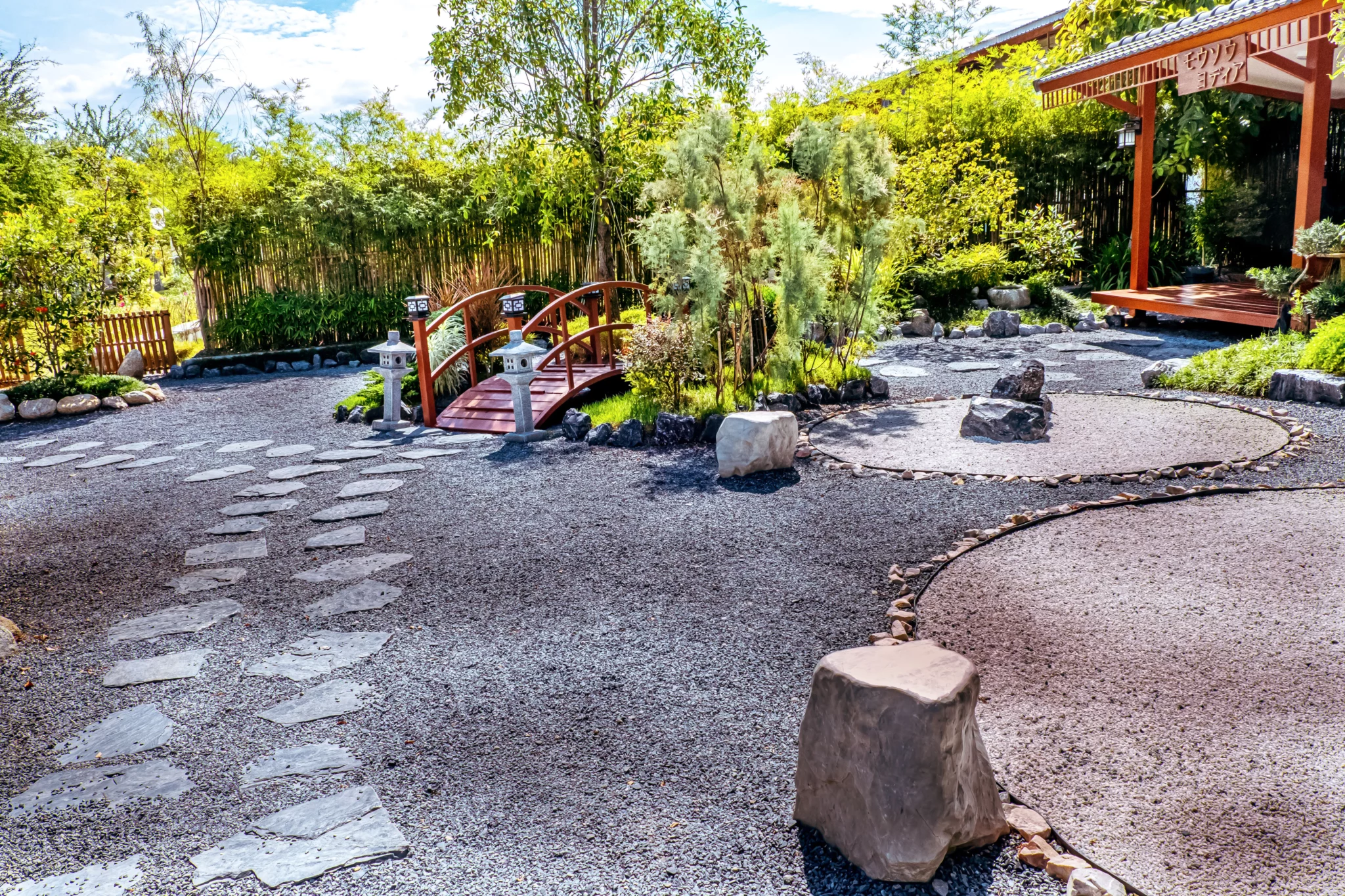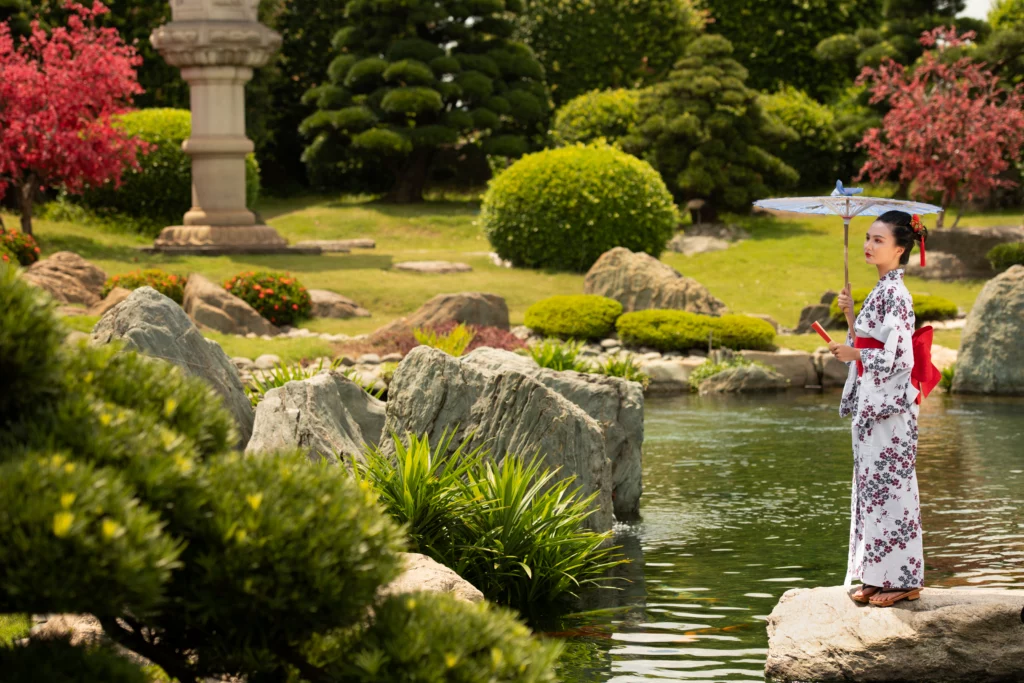The Samurai Gardens of Kyoto: Beauty and Legacy

Updated On: February 28, 2024 by Panseih Gharib
The Samurai Gardens of Kyoto manifest the refined aesthetic and philosophy characterising Japan’s historic landscape design. Rooted in the traditions of the samurai class, these gardens embody a harmony between nature, culture, and the disciplined spirit of Japan’s ancient warriors. Bearing the weight of history, each garden serves as a living canvas where the overarching principles of Japanese aesthetics, meticulous attention to detail and a deep reverence for nature manifest in an array of tranquil settings.
The convergence of history and aesthetics in Kyoto’s samurai gardens offers a unique insight into the cultural heart of Japan. Today, the remnants of these elegant spaces tell tales of past epochs while continuing to inspire through their timeless beauty.
Japanese Gardens Design
Within the Japanese Garden, the principles of design convey a profound connection to nature and a reflection of the cultural philosophy of simplicity. Through the meticulous placement of elements, each garden tells a story, expressing both transient beauty and the timeless cycles of nature.
Harmony with Nature
Japanese gardens embody the aesthetic of living in harmony with nature. They are meticulously designed to create a miniature and idealised landscape, often representing a philosophical idea of the natural world. This is achieved through careful selection and placement of plants, water features, and rocks, striving to invite the tranquil atmosphere of the countryside into urban spaces. Their approach focuses on blending the garden seamlessly with its surrounding environment, blurring the boundaries between the crafted space and nature.
Minimalism and Simplicity
The principle of minimalism permeates Japanese garden design. Simplicity is key; every element is chosen with intention and purpose, without superficial decoration. Japanese gardens often use a limited palette of materials, highlighting qualities such as the texture and colour of foliage, the clarity of water, and the natural shapes and surfaces of rocks and gravel. These spaces are not meant to overwhelm the senses but to cultivate inner calm and mindfulness, drawing our attention to the subtle details and the changing seasons.
The Role of Sand and Stones
In Japanese gardens, sand and stones play a vital role, often symbolising water and islands or helping to create a Zen-like atmosphere. Raked sand represents rippling water, promoting contemplation through its abstract patterns. Stones, sometimes chosen for their natural shapes, are carefully positioned to replicate mountainous landscapes or to act as stepping stones across dry riverbeds. Each element within the design holds symbolic significance, creating layers of meaning that offer a deeper connection to the philosophical and aesthetic foundation of the garden.
Samurai Gardens of Kyoto Historical Evolution

Before diving into the individual periods, it is important to recognise that the evolution of the samurai gardens of Kyoto reflected broader cultural and philosophical shifts, with aesthetics influenced significantly by China initially and developing unique Japanese characteristics over time.
Influences from China and the Heian Period
The Japanese gardens of the Heian Period (794-1185) boasted a significant Chinese influence, as it was a time when cultural and artistic ideas flowed between the two nations. However, this influence can be observed with nuance, as from the mid-Heian period onwards, a discernable transition aligned more closely with Japanese tastes and values began to take root. The gardens started to evolve beyond the Chinese models, incorporating native aesthetics that emphasised harmony with nature. Pond gardens, in particular, gained prominence, evolving into central features of garden designs, reflecting a desire for more immersive aesthetic interaction with the landscapes, a movement towards creating a microcosm of the natural world.
Muromachi to Edo Period Developments
As we progressed into the Muromachi Period (1336-1573), the conceptualisation of gardens continued to advance. The principles of Zen Buddhism became more influential, leading to the development of gardens that served as spiritual retreats, facilitating meditation and reflection. Known as karesansui, these rock and Zen gardens exhibited simplicity and austerity, reflecting the samurai’s embrace of Zen philosophy.
A more serene and sophisticated style developed during the Edo Period (1603-1868). Stroll gardens came to the forefront, allowing for an experiential journey through landscapes that often symbolised famous scenes from literature or history. These more intricate designs were epitomised using bridges, stepping stones, and pathways that guided one through the carefully constructed views and narratives encapsulated within the gardens.
Spiritual Significance and Zen Buddhism
In the samurai gardens of Kyoto, the interplay between Zen Buddhism and aesthetic principles reveals a profound spiritual significance that influences both the landscape design and the reflective experience of visitors.
Meditation and Mindfulness in Gardens
The structured design of a Zen garden lends itself to the practices of Meditation and Mindfulness that are central to Zen Buddhism. Meandering paths and strategically placed rocks focus the mind, allowing visitors to engage in walking meditation as they traverse these tranquil spaces. Moreover, the serene setting of the garden promotes a state of mindfulness, where the spirit can experience the present moment unencumbered by the distractions of everyday life. The austerity of the composition, devoid of excessive ornamentation, mirrors the mental discipline sought through Zen practice.
Kyoto’s gardens stand as testaments to the Samurai’s embrace of Zen Buddhism’s values:
- Appreciating the fleeting beauty of nature
- Fostering inner strength
- Living a life deeply rooted in the present
Aesthetic Concepts in Samurai Gardens
In the samurai gardens of Kyoto, aesthetics transcend mere beauty, embodying deep philosophical ideals and a connection with nature. These gardens are microcosms of harmony and tranquillity, crafted meticulously to reflect the virtues and ethos of the samurai culture.
Borrowed Scenery and Shakkei
Shakkei, or borrowed scenery, plays a pivotal role in the aesthetic landscape of these historical gardens. This concept artfully incorporates distant vistas, such as mountains or rivers, into the garden’s composition, blurring the lines between the garden and the beyond. Though not physically part of the garden, these features are strategically framed through carefully placing trees, shrubs, and openings in garden walls.
Scenery and Emptiness
Moving through the garden, one experiences the profound aesthetic of emptiness. Here, open spaces are as significant as filled ones, offering a void that stimulates contemplation. This emptiness isn’t about the absence but the potential for anything and the dynamic relation between presence and absence, imbuing the garden with a sense of temporal harmony.
In the design of a samurai garden, every element, from pebbles to ponds, is meticulously positioned to evoke a gentle conversation between aesthetics and harmony. Emptiness isn’t a void but a canvas for the mind, while borrowed scenery extends the garden’s reach, inviting reflection on life’s impermanent and interconnected nature.
Famous Samurai Gardens and Their Features
In Kyoto, gardens created during the samurai era are more than mere landscapes; they reflect their times’ deep philosophical and aesthetic values. As we explore these serene spaces, the interconnectedness of nature and meticulous design becomes evident.
Ryoan-ji’s Rock Compositions
Ryoan-ji is a temple that exemplifies the Zen garden’s elegance with its intricate rock compositions. These rocks are meticulously arranged to foster meditation and are surrounded by raked white sand, representing the purity of the void. The rock compositions are subject to interpretation, with each observer potentially seeing a different meaning within their silent forms.
The Silver Pavilion and its Sand Patterns
Ginkaku-ji, familiarly known as the Silver Pavilion, is another historic site where one can observe the artful integration of sand patterns and a tranquil pond. The sand is raked into beautiful patterns meant to symbolise water in its abstract form, enhancing the garden’s reflective tranquillity.
This garden’s aesthetic demonstrates a unity of Zen gardens’ intellectual pursuit with the samurai’s disciplined lifestyle. The Silver Pavilion does not feature silver on its structures but shines with the refined beauty and history of the period in which it was built.
Cultural Practices Within Samurai Gardens
Within the tranquil enclosures of Samurai gardens, cultural practices such as the Tea Ceremony and Noh theatre provide a profound sense of tradition and aesthetic philosophy. These activities are deeply rooted in Japanese culture and continue to be a testament to the meticulous attention to detail and respect for nature central to the Samurai way of life.
The Tea Ceremony and Garden Spaces
The Tea Ceremony, or Chanoyu, is a ceremonial practice embedded in the philosophy of Zen. These ceremonies occur in designated areas known as chaniwa, gardens with a purposeful design that complements the serene act of tea preparation and consumption. These spaces are extensions of the tea room, where every element, from the stepping stones leading to the tearoom to the koi ponds and maple trees, are intentionally placed to evoke a sense of harmony and tranquillity. The garden’s layout, often reflecting the Zen master’s influences, encourages a reflective journey, both physical and spiritual, before partaking in the Tea Ceremony, an embodiment of purity, respect, harmony, and tranquillity.
Noh Theatre and Garden Storytelling
Noh theatre is a classical form of Japanese drama that combines elements of dance, drama, music, and poetry, often performed in open-air stages adjoined to gardens. The aesthetics of Samurai gardens provide a natural backdrop to these theatrical performances, where tales of historical figures, legends, and moral narratives come to life. The garden’s ambience enhances the storytelling experience, making it a holistic sensory event. Each aspect, from the rustling leaves to the strategically placed lanterns, contributes to the narrative’s mood, resonating with the traditional elements of Japanese culture.
Through these cultural practices, the Samurai gardens of Kyoto reveal their significance beyond mere beauty. They serve as a stage where enduring traditions are preserved and celebrated, weaving the rich tapestry of Japan’s historical and cultural heritage.
Preservation and Influence on Modern Gardens
In Kyoto, the legacy of Samurai gardens continues to shape both the preservation of historical spaces and the evolution of modern landscape architecture. By ensuring these cultural landscapes endure, we contribute significantly to our historical understanding and contemporary design practices.
Maintaining Samurai Gardens Legacies
The Samurai Gardens of Kyoto are meticulously maintained, reflecting a deep respect for history and a desire to preserve Japan’s cultural treasures. Techniques such as selective pruning, gravel raking, and pond care have been passed down through generations. These practices ensure that the poignant aesthetic of these gardens remains unaltered, allowing them to stand as living monuments to the Samurai era.
Modern Garden Adaptations and Global Influence
Modern Garden design worldwide has drawn inspiration from the philosophical underpinnings of Kyoto’s samurai gardens. In Landscape Architecture, the principles of balance, harmony, and minimalism have been adapted to various settings. Internationally, these design elements can often be found in public and private spaces, serving as a testament to the extensive influence of these historic Japanese gardens.
By embracing the elements that make the samurai gardens of Kyoto unique, modern garden designers are creating spaces that foster tranquillity and reflection in a fast-paced world. This blending of past and present in landscape design honours tradition and sets a precedent for future garden aesthetics and philosophy innovations.
Visiting Kyoto’s Samurai Gardens

Exploring Kyoto’s samurai gardens offers a unique insight into Japan’s feudal history and aesthetic principles. These landscapes embody the enduring legacy of the samurai class, designed to reflect principles of beauty, discipline, and philosophy.
Preparation and Entrance Fees
Before stepping into the tranquil world of Kyoto’s samurai gardens, it’s essential to consider the practical aspects of your visit. Most gardens have an entrance fee ranging from ¥300 to ¥1000. These fees contribute to the gardens’ preservation, ensuring that the legacy of the samurai and their profound connection to nature continues to thrive. It is advisable to carry cash, as some gardens may not accept credit cards.
Experiencing Gardens Through Seasons
The beauty of Kyoto samurai gardens is that they’re meticulously designed to harmonise with the natural cycle of the seasons. In spring, they are treated to the delicate pink hues of cherry blossoms, symbolising the fleeting nature of life, a concept very much aligned with samurai philosophy. On the other hand, visiting during autumn reveals a rich tapestry of red and gold maples, reflecting the samurai’s appreciation for change and impermanence. Each samurai garden offers a distinct experience, aligning with its samurai creators’ seasons and historical context.
Conclusion
Samurai gardens are standing examples of the long history of Japanese culture. These gardens were not merely decorative features but were integral to samurai residences, symbolising power, philosophical ideas, and an appreciation for the natural world. They evolved through successive historical periods, incorporating Zen Buddhism’s spiritual significance and reflecting the changing aesthetic concepts that defined the samurai’s way of life.






